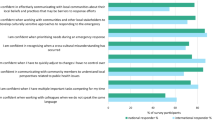Abstract
The public health workforce is diverse and encompasses a wide range of professions. For tribal communities, the Community Health Representative (CHR) is a public health paraprofessional whose role as a community health educator and health advocate has expanded to become an integral part of the health delivery system of most tribes. CHRs possess a unique set of skills and cultural awareness that make them an essential first responder on tribal land. As a result of their distinctive qualities they have the capability of effectively mobilizing communities during times of crisis and can have a significant impact on the communities’ response to a local incident. Although public health emergency preparedness training is a priority of federal, state, local and tribal public health agencies, much of the training currently available is not tailored to meet the unique traits of CHRs. Much of the emergency preparedness training is standardized, such as the Federal Emergency Management Agency (FEMA) Training Programs, and does not take into account the inherent cultural traditions of some of the intended target audience. This paper reports on the use of the Native American Talking Circle format as a culturally appropriate method to teach the Incident Command System (ICS). The results of the evaluation suggest the talking format circle is well received and can significantly improve the understanding of ICS roles. The limitations of the assessment instrument and the cultural adaptations at producing changes in the understanding of ICS history and concepts are discussed. Possible solutions to these limitations are provided.

Similar content being viewed by others
References
United States Census Bureau (2000). Arizona—American Indian Area. Population, Housing Units, Area, and Density. http://www.census.gov/census2000/states/az.html. Accessed 18 Feb 2009.
Werner, D., & Bower, B. (1987). Helping health workers learn. California: The Hesperian Foundation.
A Study of Indian Health Service and Indian Tribal Involvement in Health (1974). Department of Health, Education and Welfare.
Love, M. B., & Gardner, K. (1992). The emerging role of the community health worker in California. California: California Department of Health Statewide Survey.
Indian Health Service, Community Health Representative Website: http://www.ihs.gov/NonMedicalPrograms/chr/index.cfm?module=trainingArch. Accessed 10 Nov 2009.
Health Resources and Services Administration (2006). Office of Rural Health Policy with the Frontier Education Center. “Training Community Health Workers: Using Technology and Distance Education”. Accessed online at http://ruralhealth.hrsa.gov/pub/TrainingFrontier.asp on 9 Feb 2010.
Dunn, R., Gemake, J., Jalali, F., & Zenhausern, R. (1990). Cross-cultural differences in learning styles of elementary-age students from four ethnic backgrounds. Journal of Multicultural Counseling and Development, 18(2), 68–93.
Federal Emergency Management Agency, NIMS Resource Center Website: http://www.fema.gov/emergency/nims/. Accessed 3 Dec 2009.
Pewewardy, C. D. (2002). Learning styles of American Indian/Alaska native students: A review of the literature and implications for practice. Journal of American Indian Education, 41(3), 22–56.
Lesser, G. (1976). Cultural differences in learning and thinking styles. In S. Messick (Ed.), Individuality in learning. San Francisco: Jossey-Bass.
Centers for Public Health Preparedness Network. Improving Partnerships for Tribal Preparedness. ASPH/CDC Tribal Preparedness Resources Collaboration Group. October 2007.
Federal Emergency Management Agency, NIMS Resource Center Website: http://www.fema.gov/emergency/nims/IncidentCommandSystem.shtm. Accessed on 3 Dec 2009.
Stumpf, J. (2000). Incident command system: The history and need. The Internet Journal of Rescue and Disaster Medicine, 2(1).
The Indian Reorganization Act, June 18, 1934, (Wheeler-Howard Act—48 Stat. 984–25 U.S.C. § 461 et seq).
Cesario, S. K. (2001). Care of the native American woman: Strategies for practice, education and research. JOGNN, Principles and Practice, 30(1), 13–19.
Hodge, F. S., Pascua, A., Marquez, C. A., & Geishirt-Cantrell, B. (2002). Utilizing traditional storytelling to promote wellness in American Indian communities. Journal of Transcultural Nursing, 13(1), 6–11.
Strickland, C. J., Chrisman, N. J., Yallup, M., & Squeoch, M. D. (1996). Walking the journey of womanhood: Yakima Indian women and Papanicolaou (Pap) test screening. Public Health Nursing, 13(2), 141–150.
Hodge, F. S., Fredericks, L., & Rodriguez, B. (1996). American Indian women’s talking circles: A cervical cancer screening and prevention project. Cancer, 78(7 Suppl), 1592–1597.
Franzen, C. (2009). Native American talking circles: A culturally competent structured group intervention to address youth mental health issues. NASBHC Convention.
Wolf, P. J., & Rickard, J. A. (2003). Talking circles: A Native American approach to experiential learning. Journal of Multicultural Counseling and Development, 31, 39–43.
Renger, R., Wakelee, J., & Bradshaw, J. (2009). The hybrid exercise: Transitioning from discussion-based to operations-based exercises. Journal of Emergency Management, 7(4), 51–56.
Acknowledgments
This publication was supported by Grant U90/CCU924239-02 from the Centers for Disease Control and Prevention (CDC). Its contents are solely the responsibility of the authors and do not necessarily represent the official views of the CDC.
Author information
Authors and Affiliations
Corresponding author
Rights and permissions
About this article
Cite this article
Granillo, B., Renger, R., Wakelee, J. et al. Utilization of the Native American Talking Circle to Teach Incident Command System to Tribal Community Health Representatives. J Community Health 35, 625–634 (2010). https://doi.org/10.1007/s10900-010-9252-7
Published:
Issue Date:
DOI: https://doi.org/10.1007/s10900-010-9252-7




